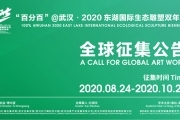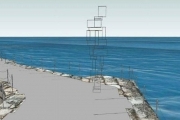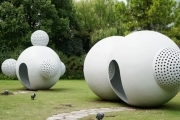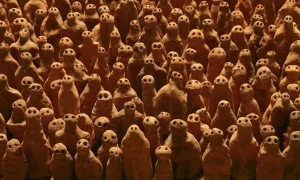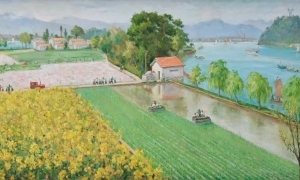策划:刘鼎
开幕时间:2008年4月19日星期六下午4点
展览时间:2008年4月20日-5月
展览地点:卓越艺术,北京市朝阳区酒仙桥路4号798艺术D区
开放时间:周二至周日上午10点至下午6点
联系电话:010-8167 9255
电子邮箱:info@joyart-beijing.com
网 址:www.joyart-beijing.com
隋建国长期以来通过雕塑实践来对雕塑的观念和形态进行思考和拓展,也同时运用录象、装置、行为等其他的媒介对社会生活形态的变迁和塑造社会生活形态的力量和机制进行反思和讨论。卓越的第二个项目“公共化的个人痕迹”是隋建国通过抽离和呈现雕塑创作中翻制和放大泥稿的过程而对个人意志被转化成公共意志的社会现实所展开的研究。
在一般的雕塑创作中,雕塑家通常是先制作一个完整的小稿,再请工人放大到雕塑家要求的尺寸,然后翻制成不同材料的作品。在“公共化的个人痕迹”的项目中,隋建国自己动手制作了三个不同形态的泥塑小稿,并有意地让自己的手印布满这三个泥塑小稿的表面。根据雕塑翻制和放大的一般程序,隋建国请工人先将他制作的泥塑手稿翻制成硅胶模具,再从硅胶模中翻制出石膏稿;接着在石膏稿上用激光定位仪进行打格定位,把石膏稿上的定位格放大十多倍,并做成定位系统,即所谓“圈套放大”的坐标圈。根据放大所需要的尺寸制作钢架及木架栅,然后将放大十多倍后的木制圈子套在木架栅上,并根据此木制圈,将雕塑泥架加在其上,完成放大稿的基本造型。工人根据放大的坐标圈进一步塑造成型,精确地表现艺术家原手稿的手迹。最终,艺术家的泥塑手稿被精确放大数十倍,成为一个巨大的具有纪念碑性质的雕塑。
在这个过程中,艺术家的私人印记或个人在泥塑小稿上的偶然触点借助一个完整和既定的公共雕塑放大制作程序而成为一种公共雕塑的成品。在被放大了十多倍的雕塑成品上,艺术家的“个人痕迹”经过放大后毫无保留地展示在公众的面前,成为一种公共性的存在和经验。一个理性的、由规则和程序掌控的、由他人执行的制作方法,以及雕塑成品的纪念碑式的体量赋予了“个人痕迹”超越个人经验而进入公共视野的途径和基础。十年前,隋建国通过挪用现成品让自己的塑造塑迹从雕塑作品上完全消失,把自己的作品变成了一件寄存在社会公共文化解读背景之上的当代艺术作品。十年后,“公共化的个人痕迹”是艺术家将自己个人的偶然的塑造痕迹,通过一个公共放大器放大从而获得了公共性的过程。私人的手迹在被放大后,呈现出某种类似巨人的接触后留下的痕迹,从个人到巨人、从普通人到巨人、从私密到公共、从真人到超人,成为一个即是个人的又非个人的存在的证据。在这中间,作为放大器的雕塑放大体系,担当了重要的角色。
无论是要达到个人目的还是实现任何社会目,都需要将个人意志转化成公共意志。这是一个很古典的问题,在直至今天,我们仍然在很本能地在运用着这个方法。在社会生活中,从产品的生产过程到生活方式的形成到公共制度的制定到文化的书写和传播到道德标准的建立,个体的意志始终通过各种方式和渠道被放大、再现和转化成为公共意志,从而获得主宰我们的权力与合法性。
“公共化的个人痕迹”讨论的不仅仅是艺术家思想的主观性和个人化印记的转化,而是在更广泛的层面上揭示公共意志的源泉,即个人欲望、意愿、野心、思想和价值观,即使进入了完全非个人化、由他人掌控和执行的、理性的生产、传播和流通的流程,结果也只是放大和强化这种个体性的需求和存在。只不过这种存在通过各种再现系统披着普遍性和合法化的外衣更加隐蔽地遍布在我们的四周并支配着我们。这些匿名和隐形的力量对从实体的建筑物、城市的规划到无形的社会规则、道德观和价值判断到国家的意识形态等方面都施加着有力的影响。在这样的现实中,“历史萎缩成了(永恒的)现在,一切事物都围绕着个体私利和个体生活而运转。”
文字:刘鼎
Sui Jianguo: Revealing Traces
Curator: Liu Ding
Opening: 4pm, Saturday, April 19, 2008
Exhibition Dates: April 20 – May 2008
Venue: JoyArt, Zone D, 798 Art District, 4 Jiuxian Qiao Road, Chaoyang District, Beijing, China
Opening Hours: 10am – 6pm, Tuesday – Sunday
Tel: +86 10 8167 9255
Email: info@joyart-beijing.com
Website: www.joyart –beijing.com
For many years Sui Jianguo has used his art practice to contemplate and expand upon sculptural concepts and forms. He also employs related media, video, installation and performance to reflect and discuss the changing patterns in our social lives and the forces and mechanisms that shape our social patterns. In JoyArt’s second artist’s project “Revealing Traces” Sui Jianguo unfolds his research through the extracting and presentation of molding and the enlargement process of a small clay model; he also examines the social phenomenon that is the transformation of individual will into the public will.
Generally, in the sculpture creation process, the sculptor first makes a complete small-scale model, workers then enlarge it to the artist’s specified dimensions, and lastly it is molded into an artwork in a different material. In the “Revealed Traces” project, Sui Jianguo personally created small-scale clay models of three different forms, he then intentionally covered their surfaces with his fingerprints. According to the general procedures for modeling and enlargement of these small sculptural models, Sui used workers to first mold his clay models into silica gel molds, then from these molds they were molded into plaster; following this, a laser mapped out the appearance of the plaster model and marked coordinate locations on a grid. This “virtual grid” of the plaster model was then enlarged more than 10 times according to an actual and comprehensive positioning system; these circular coordinates were blown up according to a “circular enlargement” process. An iron frame and wooden supports were constructed according to the requirements dictated by the new dimensions; then wooden rings were built around the wooden supports. Accordingly, the sculpture’s clay frame was built upon these wooden rings, thus completing the basic mold for the enlarged model. The workers then completed the model according to the now enlarged circular coordinates, accurately representing the handprints of the artist’s original model. Ultimately, the artist’s clay sculpture is perfectly enlarged ten times its original size; it becomes an enormous sculpture with monumental quality.
Throughout this process, by virtue of the integrated and established procedures for enlarging and creating a public sculpture, the artist’s private imprint and haphazard impressions on the original clay model are translated into a public sculptural product. This enlarged sculptural product embodies the artist’s “personal imprint” that has undergone a revealing process of magnification that holds nothing back from the public, thus evolving into its public existence and experience. This is a logical manufacturing method controlled by regulations and procedures that are executed by others, and the sculptural product’s monumental weight endows it with a “personal imprint” that exceeds the individual experience and enters the conduits and the very foundation of the public sphere. Ten years ago Sui Jianguo appropriated ready-mades in order to completely eliminate any traces of his personal experience from his sculptures, thus transforming them into contemporary art works whose existence is deciphered within the context of public culture. Ten years later, in “Revealing Traces” the artist sculpts his own haphazard imprint; through this public amplifier he enlarges them, thus achieving a communal process. Once one’s personal fingerprints have been enlarged, it appears as if a giant has left behind an imprint; from individual to a colossus, from average person to god, from personal to public, or from a real person to a superman, these become testimony to the existence of something personal, yet also impersonal. Amidst all this, the system that achieves these sculptures’ magnification assumes a major role.
No matter if they set out to achieve a personal goal or to realize society’s collective vision, they all require the transformation of the individual will into the public will. This is a classical issue, and up until today we are still instinctually using this method. In our society, from the production process, to the formation of life, to the institution of public rules, from the writing and transmission of culture, the establishment of moral standards, and from beginning to the end, individual determination is magnified through various methods and channels, recapitulating and transforming the public will, thus determining our rights and our legitimacy.
“Revealing Traces” is not merely a discussion on the subjectivity of the artist’s ideas or of the transformation of an individual’s imprint; on a broader level it reveals the source of the public will: the personal desires, aspirations, ambitions, ideology and values of the individual. Even though the manufacturing process is executed and manipulated by others, it is rationally produced, and its propagation and circulation is completely impersonal; the result is the enlargement and intensification of the individual’s desires and existence. Draped as a cloak of universality and legitimacy, this kind of existence is concealed everywhere around us, and it governs us through its various resurgent devices. These anonymous and invisible forces impose a powerful influence on society, from architectural entities, urban planning, intangible social rules, moral concepts, value judgments and even to national ideology. In such a reality, “History has withered to become the now, everything revolves around the individual’s personal gain and the individual’s life.”
Text by Liu Ding
【编辑:贾娴静】


